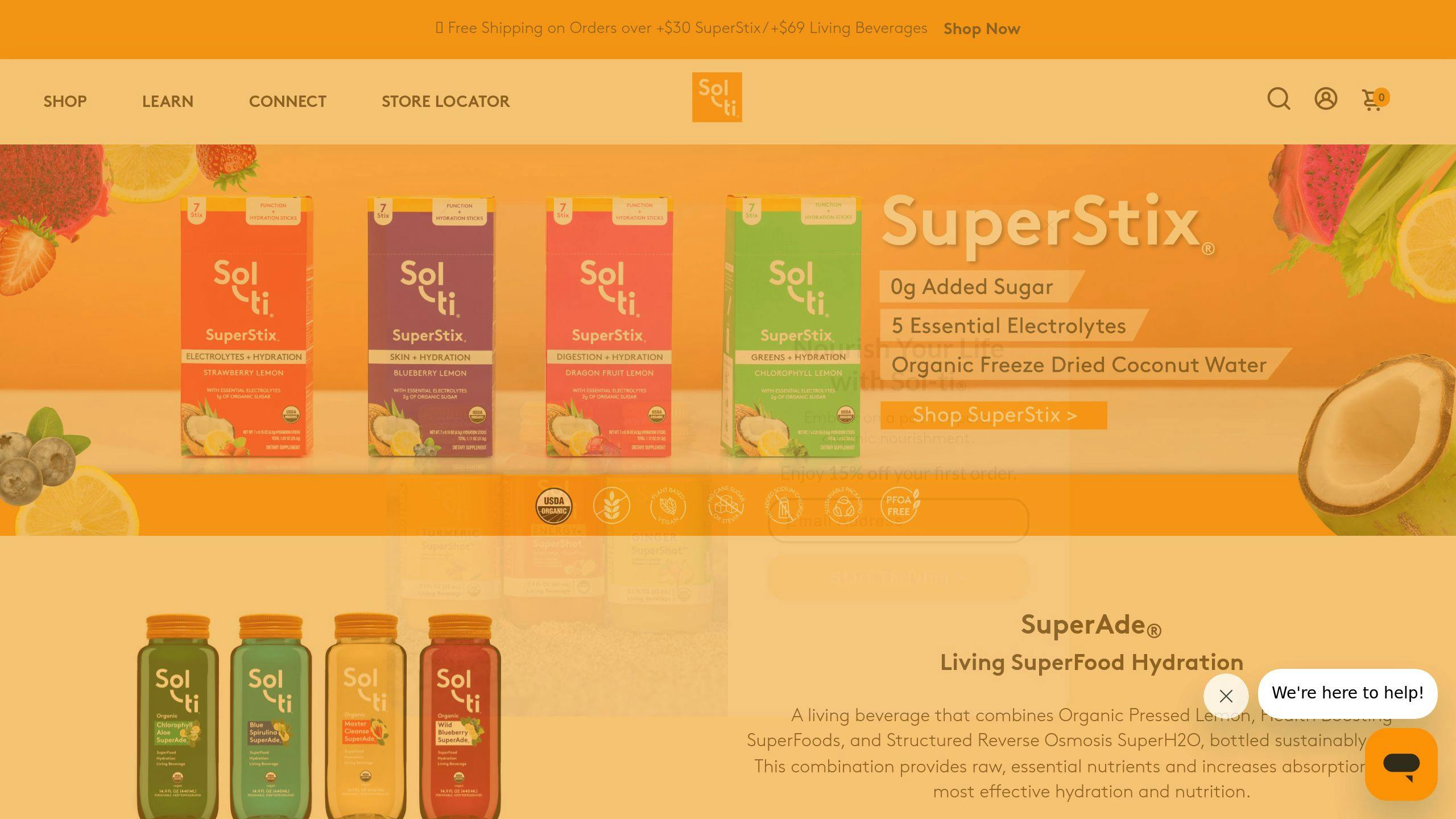Structured water, also called EZ water or gel water, is a unique form of water with a hexagonal molecular structure (H3O2) that differs from regular water (H2O). Found in nature (e.g., mountain springs, fresh fruits, and living cells), it is believed to offer potential health benefits like enhanced hydration, improved nutrient absorption, and antioxidant properties. Unlike alkaline water, its benefits come from its molecular arrangement rather than pH levels. While early studies suggest it may support cellular function and reduce oxidative stress, more research is needed to confirm these claims.
Key Points:
- Molecular Structure: Organized hexagonal (H3O2) vs. random (H2O in regular water).
- Natural Sources: Glacier melts, mountain springs, fruits, vegetables, and living organisms.
- Health Potential: May improve hydration, energy, and nutrient absorption.
- Scientific Debate: Early findings are promising but require further validation.
Quick Comparison:
| Feature | Regular Water | Structured Water |
|---|---|---|
| Molecular Pattern | Random | Hexagonal |
| Stability | Unstable | Stable |
| Structure Type | H2O | H3O2 |
| Key Benefits | Basic hydration | Enhanced hydration, antioxidant effects |
Structured water is gaining attention in wellness and hydration products, but its claims remain a topic of scientific scrutiny.
Water, Cells, and Life
What Is Structured Water?
Structured water, often referred to as hexagonal or EZ (exclusion zone) water, has molecules arranged in a stable H3O2 pattern. Unlike the random molecular arrangement of regular water, this type forms a more organized structure near hydrophilic surfaces under specific conditions [1] [5].
Understanding the Hexagonal Structure
This hexagonal arrangement develops near hydrophilic surfaces, where water molecules organize into a stable H3O2 configuration. This structure is thought to influence water's interaction with living cells, potentially impacting its biological properties [1] [5].
| Feature | Regular Water | Structured Water |
|---|---|---|
| Molecular Pattern | Random | Hexagonal |
| Stability | Unstable | Stable |
| Formation | Random state | Near hydrophilic surfaces |
| Structure Type | H2O | H3O2 |
Where to Find Structured Water in Nature
Structured water naturally forms in environments that meet specific conditions [1] [6] [5]:
- Glacier Melt: High pressure and mineral-rich environments encourage its formation.
- Mountain Springs: Natural filtration and mineral exposure support the hexagonal structure.
- Living Organisms: Found within the cells of plants and animals.
Factors like sunlight, interaction with minerals, and natural movement contribute to the formation and preservation of structured water's hexagonal pattern [1] [6] [5].
This organized structure sets structured water apart from regular water, which we'll delve into further next.
How Is Structured Water Different from Regular Water?
Structured water stands out due to its unique molecular arrangement and how it interacts with living systems.
Molecular Structure Differences
The key difference lies in how the molecules are arranged. In regular water, molecules are organized randomly. Structured water, on the other hand, forms a stable hexagonal pattern (H3O2) [1][5]. This unique organization leads to several distinctions:
| Property | Regular Water | Structured Water |
|---|---|---|
| Molecular Organization | Random and unstable | Hexagonal and stable |
| Mineral Bioavailability | Standard absorption | Improved mineral absorption |
| Antioxidant Properties | Limited | Greater antioxidant capacity |
Dr. Gerald Pollack suggests that the hexagonal structure of structured water could enhance its interaction with cells [5][3]. This improved structure may support better cellular hydration and overall function [1][2].
Structured Water vs. Alkaline Water
Structured water is often confused with alkaline water, but they are quite different [6][5]. Here's how they compare:
- Alkaline Water: Created to have a higher pH through processes like filtration or electrolysis.
- Structured Water: Naturally forms a hexagonal molecular pattern near hydrophilic surfaces, independent of pH.
The benefits of structured water come from its molecular organization, not its pH level [6][3]. This sets it apart, as its properties go beyond just pH to potentially affect biological processes.
Sources like mountain springs naturally preserve structured water's hexagonal formation due to specific environmental conditions [1][5]. These differences explain why structured water is gaining interest for its potential impact on health, which we'll dive into further in the next section.
Possible Health Effects of Structured Water
Improved Hydration and Nutrient Absorption
The hexagonal structure of structured water is believed to improve how water interacts with cell membranes, leading to better hydration and nutrient absorption [1][2]. Here's how it might help:
| Benefit | What It Does |
|---|---|
| Cellular Hydration | Promotes better water uptake at the cellular level. |
| Nutrient Transport | Delivers minerals and nutrients more effectively. |
| Cellular Function | Enhances cell performance and communication. |
Energy and Mood Benefits
Structured water might help boost energy levels and improve mood by supporting mitochondrial function and lowering oxidative stress. This could lead to increased energy production at the cellular level [2]. Some key benefits include:
- Higher cellular energy production
- Reduced oxidative stress
- Enhanced vitality and well-being
"Structured water can increase mitochondrial energy output by donating free electrons to mitochondria, which can lead to higher energy levels and improved mood", according to recent research findings [2].
Other Potential Health Effects
Preliminary studies suggest that structured water could offer a range of health benefits, although more research is needed. For instance, a 2021 study found that drinking structured water for three months could potentially reduce biological markers of aging by up to 12 years [2]. Additional reported benefits include:
| Health Aspect | Possible Advantage |
|---|---|
| Inflammation | May help lower inflammatory responses. |
| Antioxidant Activity | Could provide better defense against oxidative stress. |
| Cellular Function | Supports improved cell performance overall. |
Brands like Sol-ti have started incorporating structured water into their products, tapping into the growing interest in natural wellness solutions [6]. While these findings are intriguing, they require further scientific validation, as we’ll dive into next.
sbb-itb-74fe2fe
Scientific Studies and Debates
What Research Says So Far
Scientific studies have investigated structured water's molecular properties and how they might relate to health. Dr. Gerald Pollack from the University of Washington has conducted studies that focus on these molecular characteristics and their possible health effects [1][5].
| Research Area | Key Findings | Study Details |
|---|---|---|
| Aging Effects | 12-year reduction in biological age markers | 3-month study (2021) [2] |
| Cellular Energy | Increased mitochondrial energy output | Laboratory analysis [2] |
| Molecular Structure | Confirmed hexagonal arrangement | Multiple studies [4][5] |
"Light and heat alter water's molecular structure, affecting how it interacts with our bodies." - Dr. Gerald Pollack, University of Washington [3]
Although these findings are intriguing, they have also drawn criticism and sparked debate within the scientific community.
Why Some Scientists Are Skeptical
Not all researchers agree on the claims surrounding structured water. Concerns about the quality of studies have raised questions about its credibility.
| Criticism | Details | Impact on Credibility |
|---|---|---|
| Study Design | Small sample sizes and weak controls | Undermines reliability |
| Funding Bias | Studies often funded by product manufacturers | Creates potential conflicts |
| Mechanism Understanding | Lack of clarity on how benefits occur | Challenges effectiveness |
1. Methodology Concerns: Many studies fail to include robust controls or large enough sample sizes to draw reliable conclusions [1][2].
2. Theoretical Gaps: Current science doesn't fully explain how structured water might provide the claimed benefits [1][2].
3. Independent Verification: More independent research is needed to confirm the initial findings [1][5].
While early studies hint at potential benefits, the scientific community emphasizes the need for more rigorous research to determine whether structured water can deliver on its claims [2][5]. These criticisms underline the importance of further investigation to ensure the findings are both reliable and unbiased.
How Structured Water Is Used in Products Today
Structured water is making its way into the wellness market, especially in beverages. This trend showcases the growing interest in hydration and health-focused solutions. Here's a quick look at how it's being used:
| Product Category | Key Features | Target Benefits |
|---|---|---|
| Wellness Beverages | Organic ingredients, eco-friendly packaging | Supports overall health |
| Immunity Drinks | Functional superfoods | Boosts immune function |
| Portable Hydration | Concentrated minerals | Convenient for active lifestyles |
Sol-ti and Structured Water Beverages

Sol-ti has embraced structured water in its range of organic drinks. Their lineup includes hydration drinks, immunity shots, and portable wellness options, all crafted with organic ingredients and packaged in sustainable glass bottles. The company also uses UV Light Filtered™ manufacturing to ensure product quality and address health and environmental concerns.
With structured water being incorporated into wellness beverages, its potential to improve hydration and support immunity is gaining attention. As this trend develops, learning about its properties can help consumers make better choices.
Conclusion: What to Remember About Structured Water
The science behind structured water is still developing, with early findings pointing to some interesting possibilities. Studies suggest it may:
- Support hydration by aiding cellular absorption [1][5]
- Improve how the body absorbs nutrients and minerals [1][2]
- Offer antioxidant effects, potentially reducing oxidative stress [1][2][5]
Dr. Gerald Pollack's research has brought attention to structured water's unique properties. However, the broader scientific community remains cautious, emphasizing the need for more thorough studies to confirm these claims [1][2].
Meanwhile, the wellness industry is already taking notice. Companies are integrating structured water into their products, often pairing it with eco-friendly practices and other functional ingredients. This trend mirrors a growing interest in health-conscious and environmentally aware lifestyles [5][4].
As more research unfolds, the potential role of structured water in health and hydration could become clearer. For now, it sits at the intersection of science and natural wellness, offering an intriguing area for further exploration.
FAQs
What does structured water do to your body?
Structured water is thought to offer various health perks, according to early studies and expert opinions. Dr. Gerald Pollack, a leading researcher in this area, explains:
"Structured water is the formation found within our cells, in fruits and vegetables, springs and mountains and elsewhere throughout nature." [5]
Its hexagonal molecular structure is believed to promote better cellular hydration, enhance nutrient absorption, support energy production by improving mitochondrial function, and assist in detoxification due to its unique properties [1][2][5]. These effects are linked to the water's molecular arrangement and its negative charge [2].
Brands like Sol-ti are now including structured water in their wellness drinks, blending it with organic ingredients to amplify potential health benefits. While these possibilities are intriguing, more research is needed to fully understand its role in overall health [1][4].


